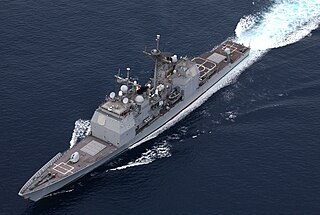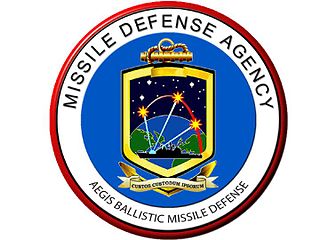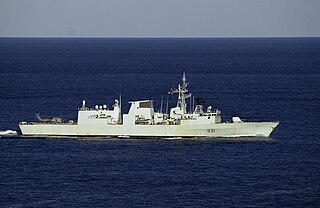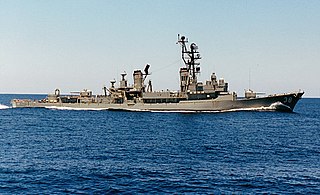
The TomahawkLand Attack Missile (TLAM) is a long-range, all-weather, jet-powered, subsonic cruise missile that is primarily used by the United States Navy and Royal Navy in ship and submarine-based land-attack operations.

An anti-ship missile (AShM) is a guided missile that is designed for use against ships and large boats. Most anti-ship missiles are of the sea skimming variety, and many use a combination of inertial guidance and active radar homing. A good number of other anti-ship missiles use infrared homing to follow the heat that is emitted by a ship; it is also possible for anti-ship missiles to be guided by radio command all the way.

The Type 23 frigate or Duke class is a class of frigates built for the United Kingdom's Royal Navy. The ships are named after British Dukes, thus leading to the class being commonly known as the Duke class. The first Type 23, HMS Norfolk, was commissioned in 1989, and the sixteenth, HMS St Albans was commissioned in June 2002. They form the core of the Royal Navy's destroyer and frigate fleet and serve alongside the Type 45 destroyers. They were designed for anti-submarine warfare, but have been used for a range of uses. Twelve Type 23 frigates remain in service with the Royal Navy, with three vessels having been sold to the Chilean Navy, and one being retired in 2021.

The Arleigh Burke class of guided-missile destroyers (DDGs) is a United States Navy class of destroyer built around the Aegis Combat System and the SPY-1D multi-function passive electronically scanned array radar. The class is named for Admiral Arleigh Burke, an American destroyer officer in World War II and later Chief of Naval Operations. The lead ship, USS Arleigh Burke, was commissioned during Admiral Burke's lifetime.

The Aegis Combat System is an American integrated naval weapons system developed by the Missile and Surface Radar Division of RCA, and it is now produced by Lockheed Martin.

The Aegis Ballistic Missile Defense System, also known as Sea-Based Midcourse, is a United States Department of Defense Missile Defense Agency program developed to provide missile defense against short to intermediate-range ballistic missiles. The program is part of the United States national missile defense strategy and European NATO missile defence system.

The Type 45 destroyer, also known as the D or Daring class, is a class of six guided-missile destroyers built for the United Kingdom's Royal Navy in the early 21st century. The class is primarily designed for anti-aircraft and anti-missile warfare and is built around the PAAMS air-defence system using the SAMPSON Active electronically scanned array (AESA) and the S1850M long-range radars. The first three destroyers were assembled by BAE Systems Surface Fleet Solutions from partially prefabricated "blocks" built at different shipyards; the remaining three were built by BAE Systems Maritime – Naval Ships. The first ship in the Daring class, HMS Daring, was launched on 1 February 2006 and commissioned on 23 July 2009.

The Halifax-class frigate, also referred to as the City class, is a class of multi-role patrol frigates that have served the Royal Canadian Navy since 1992. The class is the outcome of the Canadian Patrol Frigate Project, which dates to the mid-1970s. HMCS Halifax was the first of an eventual twelve Canadian-designed and Canadian-built vessels which combine traditional anti-submarine capabilities with systems to deal with surface and air threats as well. All ships of the class are named after a major city in each province plus the cities of Ottawa and Montreal.
The Type 26 frigate or City-class frigate is a class of frigate being built for the United Kingdom's Royal Navy, with variants also being built for the Australian and Canadian navies. The programme, known as the Global Combat Ship, was launched by the UK Ministry of Defence to partially replace the navy's thirteen Type 23 frigates, and for export. Its primary role is to conduct advanced anti-submarine warfare missions while supporting air defence and general purpose operations. The type is the first naval platform shared between Australia, Canada and the United Kingdom since the Tribal-class destroyer.

USS Mason (DDG-87) is an Arleigh Burke-class destroyer in the United States Navy. She is named in honor of the non-segregated crew serving on board USS Mason (DE-529). This ship is the 37th destroyer of her class. USS Mason was the 21st ship of this class to be built at Bath Iron Works in Bath, Maine, and construction began on 19 January 2000. She was launched and christened on 23 June 2001. On 12 April 2003, a commissioning ceremony was held at Port Canaveral, Florida. She is currently homeported in Mayport, Florida.

The Anzac class is a ship class of ten frigates; eight operated by the Royal Australian Navy (RAN) and two operated by the Royal New Zealand Navy (RNZN). During the 1980s, the RAN began plans to replace the River-class destroyer escorts with a mid-capability patrol frigate and settled on the idea of modifying a proven German design for Australian conditions. Around the same time, the RNZN was seeking to replace their Leander-class frigates while maintaining blue-water capabilities. A souring of relations between New Zealand and the United States of America in relation to New Zealand's nuclear-free zone and the ANZUS security treaty prompted New Zealand to seek improved ties with other nations, particularly Australia. As both nations were seeking warships of similar capabilities, the decision was made in 1987 to collaborate on their acquisition. The project name is taken from the Australian and New Zealand Army Corps of the First World War.

HMCS Vancouver is a Halifax-class frigate, of the Royal Canadian Navy launched on 8 July 1989, as the second vessel of her class. She is based at CFB Esquimalt on the west coast of Canada, and is the third vessel to be named after Vancouver, British Columbia.

The BAE Systems Mark 36 Super Rapid Bloom Offboard Countermeasures Chaff and Decoy Launching System is an American short-range decoy launching system (DLS) that launches radar or infrared decoys from naval vessels to foil incoming anti-ship missiles. The decoys present false signals and interference to the attacking missiles' guidance and fire-control systems. The Mark 36 SRBOC is similar to the Sea Gnat decoy system.

HMCS Regina is a Halifax-class frigate that has served in the Canadian Forces and Royal Canadian Navy since 1993. Regina is the fifth vessel in her class which is the name for the Canadian Patrol Frigate Project. She is the second vessel to carry the designation HMCS Regina. She is assigned to Maritime Forces Pacific (MARPAC) and is homeported at CFB Esquimalt.

The Hobart class is a ship class of three air warfare destroyers (AWDs) built for the Royal Australian Navy (RAN). Planning for ships to replace the Adelaide-class frigates and restore the capability last exhibited by the Perth-class destroyers began by 2000, initially under acquisition project SEA 1400, which was re-designated SEA 4000. Although the designation "Air Warfare Destroyer" is used to describe ships dedicated to the defence of a naval force from aircraft and missile attack, the planned Australian destroyers are expected to also operate in anti-surface, anti-submarine, and naval gunfire support roles.
The Royal Australian Navy, although a significant force in the Asia-Pacific region, is nonetheless classed as a medium-sized navy. Its fleet is based around two main types of surface combatant, with limited global deployment and air power capability. However, in 2009, a white paper, Defending Australia in the Asia Pacific Century: Force 2030, was produced by the Australian government which set out a programme of defence spending that will see significant improvements to the RAN's fleet and capabilities.

The Perth-class destroyers were three modified Charles F. Adams-class guided missile destroyers operated by the Royal Australian Navy (RAN). Ordered from Defoe Shipbuilding Company during 1962 and 1963, HMA Ships Perth, Hobart, and Brisbane were the first guided missiled-armed warships, and the first naval ships of United States design, to enter service with the RAN. All three ships operated during the Vietnam War, while Brisbane also participated in the Gulf War. The class was decommissioned between 1999 and 2001, with all three vessels later sunk as dive wrecks.

The AGM-158C LRASM is a stealthy anti-ship cruise missile developed for the United States Air Force and United States Navy by the Defense Advanced Research Projects Agency (DARPA). The LRASM was intended to pioneer more sophisticated autonomous targeting capabilities than the U.S. Navy's current Harpoon anti-ship missile, which has been in service since 1977.

The Mark 41 Vertical Launching System is a shipborne missile canister launching system which provides a rapid-fire launch capability against hostile threats. The Vertical Launch System (VLS) concept was derived from work on the Aegis Combat System.
Aegis system equipped vessels (ASEV) or イージス・システム搭載艦 in Japanese is the designation for a proposed pair of cruiser-sized ballistic missile defense (BMD) warships to be operated by the Japanese Maritime Self Defense Force (JMSDF) as dedicated ship-based BMD platforms, serving as an alternative to Japan's now-cancelled land-based Aegis Ashore BMD system. When completed, the two warships will be the largest surface combatant ships in service with the JMSDF, and according to Popular Mechanics, they will "arguably [be] the largest deployable surface warships in the world."

















